This is Kamimori from the design department.
This may be a sudden question, but do you know of a school called IAMAS ?
I know that many of you already know this, but I will explain it.
IAMAS (Institute of Advanced Media Arts and Sciences) is a graduate school located in Ogaki City, Gifu Prefecture.
He teaches and researches academic theory and applications that aim to combine scientific intelligence and artistic sensibility.
It is popularly known by its English abbreviation, IAMAS.

IAMAS Campus
Shigeru Kobayashi, who has been helping our company, is a professor at IAMAS, and Yosuke Hayashi is a graduate of the school.
I have long been interested in IAMAS, a graduate school with many outstanding professors and graduates.
However, although I was interested, I couldn't really imagine what it would be like. It seemed like they were doing something high-tech, but it wasn't located in the city center, but in Ogaki City, Gifu Prefecture. Graduates have been active in a wide range of fields, and there were no other schools similar to it, so I could only imagine what it would be like by reading articles on the Internet.
In the midst of all this, I learned that IAMAS's 16th graduation research presentation session would be held from February 22nd to 25th.
This seemed like a good opportunity to check it out for myself, so I quickly booked my Shinkansen ticket and headed out from Tokyo.
This time, we would like to introduce a few selected pieces from the 16th graduation research presentations and hope to deepen your understanding of IAMAS a little.
Leaves
Author: Ayumi Nagamatsu
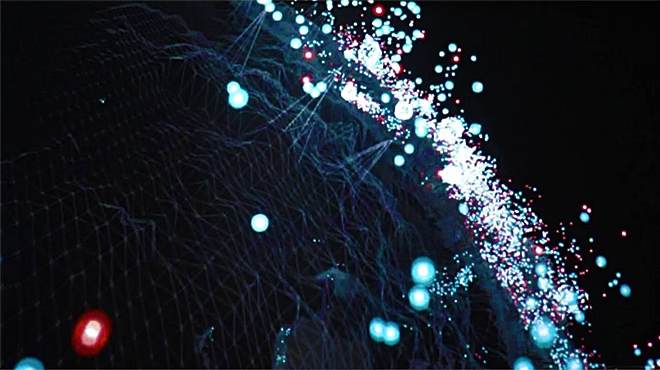
Institute of Advanced Media Arts and Sciences: http://www.iamas.ac.jp/activity/isca2017/
When I arrived at the venue, I felt intimidated for some reason by the large banner right in front of me that read "IAMAS 2018 Graduation and Project Research Exhibition," so I took a side path and decided to look at an exhibit a little distance from the main floor.
We entered a smaller exhibition room at the back, where beautiful images were being projected onto three large screens.
The image showed a globe and terrain displayed in wire-like form, surrounded by countless dots emitting red and blue light, and a bell-like "ding" sound was heard periodically in the silence.
Although I thought it was beautiful, I couldn't understand the intent of the piece just by looking at it, so I decided to read a summary.
As I continued to read the synopsis, I felt a little uneasy...or perhaps a somewhat complicated feeling.
The video was actually a statistical simulation of deaths by suicide.
It collects data from World Health Organization reports and places glowing dots at the locations where suicides have occurred (globes on wires). A periodic "ding" sound notifies you that a suicide is statistically likely to have occurred, and a glowing dot is added to the globe.
According to a report from the World Health Organization, a suicide death occurs every 40 seconds. I get goosebumps every time I hear that sound.

The image can be changed by operating the buttons on the iPad.
The reason I have mixed feelings is because when I first saw the footage I thought it was beautiful.
It may be inappropriate to think it's beautiful, but the images themselves are undoubtedly beautiful.
The countless glowing, floating dots looked like the light of fireflies or the souls of each individual, and somehow they seemed like something sacred.
node hands
Author: Takemi Watanuki

Takemi Watanuki's website: https://watakemi725.github.io/app_nodeHands
As I got used to the atmosphere of the venue, I walked past the large banner that had made me feel intimidated just a few minutes earlier and headed to the main floor.
On the main floor, there were a dozen or so master's works lined up, and in one corner was a human hand clutching a smartphone. Of course, it wasn't a real hand, but a mechanical device that imitated a human hand, and there were about 20 of them, each of which seemed to be squirming.
The mechanical device, which resembles a hand, appears to be able to operate a smartphone with movements similar to those of a human, such as tapping the smartphone with the thumb, and manipulate round-shaped objects on the smartphone screen.
The summary says that the work expresses the emptiness of communication in modern times.
The round object on the smartphone screen visualizes the information being sent to and received from another smartphone in the same location, and the sending and receiving (information exchange) is completed here.
The smooth movement of the mechanical device that resembles a hand and the visualization of sending and receiving data on the smartphone screen were extremely well-crafted, allowing us to visualize it as a bird's-eye view of our everyday lives using smartphones.
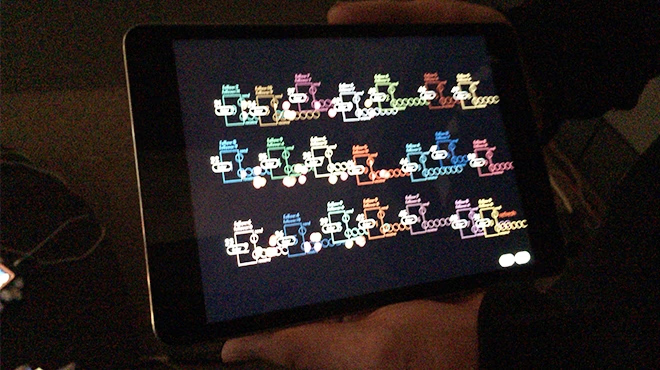
We also had the opportunity to speak directly with the creator, Takemi Watanuki, and he showed us some examples of the application.
It appears that the application is consistent throughout, with balls being thrown and received from each box, and each device sending and receiving information.
However, since it doesn't fit the concept, it won't be exhibited. I can imagine how many prototypes must have been made before it was exhibited here.
me,myself&us( wanderlust・fa(r)ther)
Author: Seitaro Kosaka
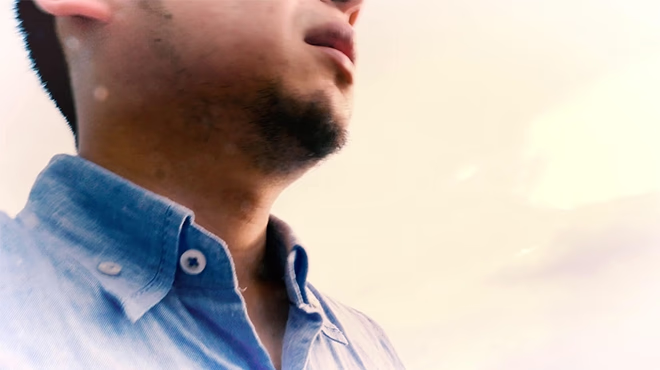
IAMAS 2018 Graduation and Project Research Exhibition: http://www.iamas.ac.jp/exhibit18/works
At the back of the venue there was a theater room where Kosaka Seitaro's two-part self-documentary series "me, myself&us" was being shown.
In the first part, "wanderlust," he reflects on his life over a three-month stay in Europe and expresses his plans for the future.
The book contains his own words about his life at the host country, his worries, and the changes in his state of mind. At first he appears to have been troubled, but by the time he returned to Japan he appears to have sorted out his feelings and grown a lot.
Perhaps because the author, Takasaka, and I are of the same generation, I was able to empathize with his worries and the vague feelings that are difficult to put into words.
The second part, "fa(r)ther," is prompted by the death of the artist's father, with whom he had a stigma, and attempts to capture the existence of a father and the seemingly strong yet fragile relationship of blood ties.
His mother and other relatives appear in the show and talk to Takasaka about his father. As he learns about the father he knows and the father he doesn't know, and as he grasps the relationships his father had with those around him when he was alive, he tries to understand the relationship between his father and himself from multiple perspectives.
It seemed to me that she was sorting out the complicated feelings that arose from her relationship with her father by expressing them through her videos of him.
Solidifying
Author: Kazuma Harada
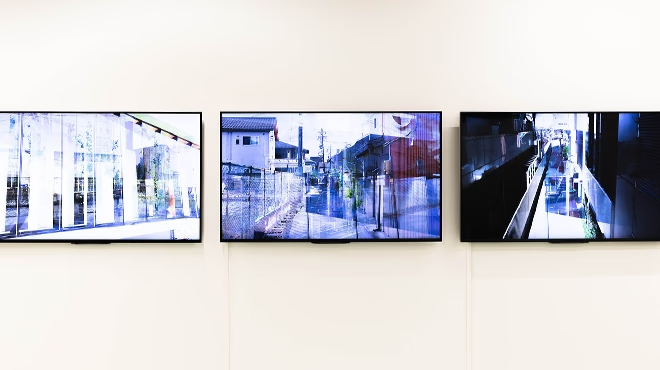
IAMAS 2018 Graduation and Project Research Exhibition: http://www.iamas.ac.jp/exhibit18/works
The last piece I would like to introduce is "Solidifying" by Kazuma Harada.
At first, I thought it was a collage. But when I looked closely, I noticed that the pictures changed at a level that you might or might not notice. They seemed to move, and the pictures changed gradually.
According to the summary, the work is considered to be a "photographic expression with a time axis," in which multiple overlapping photographs change as their opacity changes.
I immediately realized that it was a medium somewhere between photography and video.
However, if we think of photography as something that freezes a scene from the past, then this is not the case.
It cannot convey information in a short amount of time like a video.
If it doesn't have the characteristics of a photograph or a video, then perhaps it's not somewhere between a photograph and a video. It's a different medium, and I felt it had new possibilities.
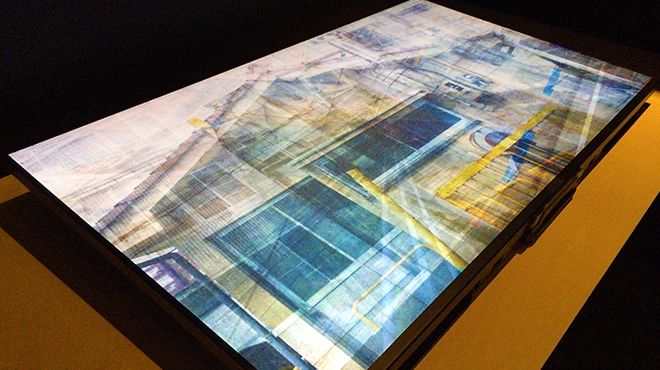
Experience a variety of works.
Having had the opportunity to view the graduation exhibition, I was impressed by the many works that were both technically and artistically excellent, truly demonstrating the "fusion of technology and art" that IAMAS promotes, and felt that technology is broadening the scope of artistic expression.
One thing that surprised me was that it wasn't all about technology.
There is also a lot of cultural content, such as movies (videos), manga, and music.
Before seeing the exhibition, I had imagined that most of the students would be from science backgrounds specializing in digital technology, but the graduation works displayed were truly diverse.
The school has a system in place to support the diverse research topics of its students, and I felt there was a liberal culture that encouraged this.
I will continue to keep an eye on IAMAS and the achievements of its graduates.

